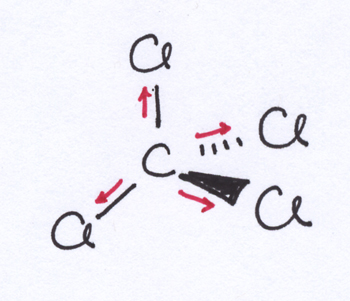Question #c3802
1 Answer
Carbon tetrachloride, or
The
A molecule is not polar simply because it has polar bonds; having polar bonds is a must, but it is just half of the story. The other half is the molecular geometry.
The carbon tetrachloride molecule has a tetrahedral molecular geometry, which implies symmetry in 3D space.
The dipole moments that arise for each

As a result, the net dipole moment for this molecule will be zero, which in turn will cause the molecule to be nonpolar and thus insoluble in water, a polar solvent.
So, when trying to determine the polarity of a molecule, keep in mind two things
- The molecule must have polar bonds;
- If polar bonds are present, then the molecular geometry must allow for the existance of a net dipole moment, i.e. not be symmetric (assuming all the polar bonds present have equal dipole moments).

